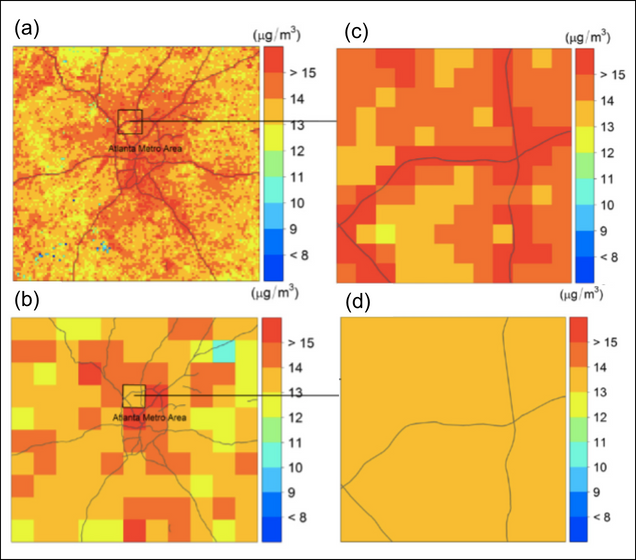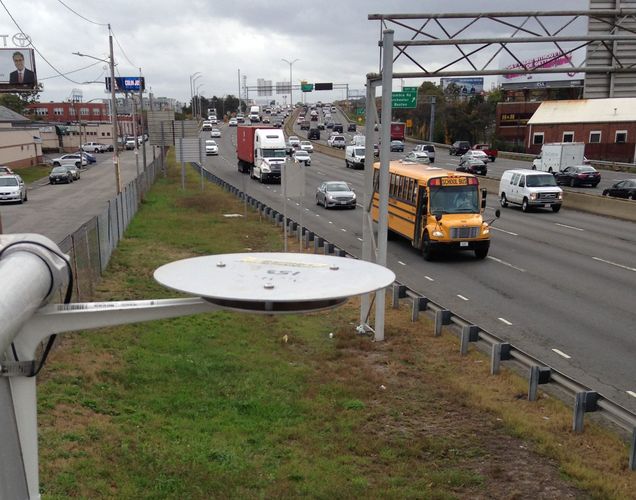Research
Objectives:

Air pollution analysis at “community scale” – on the order of kilometers or less corresponding to individual neighborhoods or localities – is increasingly becoming important as public health interest becomes more locally oriented. A good example of a specific policy is California’s recent AB617 legislation with the established Community Air Protection Program (CAPP).
Through five research aims, this Tiger Team Project demonstrates existing and in-development techniques to better enable stakeholders in these and other communities to carry out health-based air quality assessments at relevant community scales incorporating measurements from satellites. The central NASA satellite product underlying this work is aerosol optical depth (AOD) from the new 1-km resolution Multi-Angle Implementation of Atmospheric Correction (MAIAC) retrieval algorithm. Among our uses of MAIAC is the construction of gridded PM2.5 spatial fields using land-use regression modeling and health-risk assessment based on these fields (Aims 2 and 5). A second focus is the exploration of the utility of the University of North Carolina Passive Aerosol Sampler (UNC PAS; Aim 1), which could make more feasible community-scale assessment of long-term PM air pollution health risk. We also explore methods by which MAIAC and other satellite products and low-cost sensors can be incorporated into dispersion modeling analysis of local-scale air quality problems (Aims 3 and 4).
In summary, developing and demonstrating techniques for community scale air quality and health risk analysis drawing on the synergy of high-resolution satellite data, low-cost air quality sensors, and advanced statistical and dispersion modeling techniques is the focus of this project.
Aims:

- In Boston, New York City, San Francisco Bay Area and California’s Imperial Valley, pilot test a novel passive aerosol sampler designed to measure long-term average concentrations of PM2.5 and PM10-2.5, and to characterize both particle size and composition. Quantify accuracy and precision with respect to co-located surface measurements using high-cost regulatory monitors. Continue reading.
- Produce daily, monthly and annual surface PM2.5 concentration estimates across the communities of interest using satellite-based data from the 1-km resolved MAIAC MODIS/AOD retrieval algorithm combined with local land use variables and meteorological variables and available surface measurements, including data from low-cost sensors where possible. Continue reading.
- Using air dispersion modeling, MAIAC and other satellite products, as well as low-cost sensor measurements from the IVAN network, investigate local-scale particulate air pollution problems affecting the California Imperial Valley. Among the problems being investigated are wind-blown dust events. Continue reading.
- For periods of large-scale wildfire smoke impacts, use available ground-based monitoring data (permanent, temporary-smoke, and low-cost sensors where possible) in combination with the 1-km satellite–derived PM2.5 surfaces and total column AOD products to optimize air dispersion modeling at 1.33-km and 2-km resolutions, resolving PM2.5 concentrations from wildfires. Continue reading.
- Compute health impacts from PM2.5 at the 1 km scale, using the exposure estimates developed in Aims 2-4. Continue reading.
Study Sites and Stakeholder Interest:
The above methods are being developed in five locations: New York City (NY), Boston (MA), Los Angeles (CA), Imperial Valley (CA) and San Francisco Bay Area (CA) to build on strong ongoing partnerships in each location. These locations are also ones with relatively high-resolution air monitoring networks and active low-cost sensor network programs
The New York City Community Air Survey (NYCCAS), operated by the NYC Department of Health (DOH), has been underway since 2008 and measures quarterly and annual average PM2.5 concentrations at over 60 sites spread across the NYC metropolitan region. NYC DOH is interested in linking remotely sensed and modeled air quality data to update their health impact assessments for NYC.
In Boston, we work with the City of Boston Environment Department and the Boston Public Health Commission to characterize existing patterns of PM2.5 concentrations across the metropolitan area using both satellite and low-cost sensor data, laying the groundwork for scenario-based assessments of future improvements in air quality and health resulting from a range of carbon mitigation options under consideration by Boston to achieve their zero carbon goal for 2050.
In Los Angeles, the South Coast Air Quality Management District provides low cost sensor data from field tests across their basin to help support PM2.5 surfacing based on MAIAC satellite fields. Through their AQ-Spec program, SCAQMD has a well-established program for testing and applying low-cost sensors. The district is interested in how particulate fields from remote sensing can augment their understanding of PM2.5 patterns in the Eastern part of their air basin (Riverside, San Bernardino area), where average PM2.5 concentrations are highest.
The Imperial County Community Air Project run by California Department of Public Health (CalDPH) assesses air quality in predominantly Hispanic at-risk communities with very high asthma rates through a dense array of low-cost sensors (https://ivan-imperial.org/air/map). These low-cost monitoring will help support PM2.5 surfacing based on MAIAC satellite fields. Project participants are interested in better understanding measured data, particularly source areas that lead to high concentration periods and episodes.
The Bay Area Air Quality Management District (BAAQMD) has ongoing monitoring, modeling and data analysis efforts to develop, implement and assess health effects benefits of policies aimed at reducing PM2.5 exposure. The California Assembly Bill AB617 legislation is current priority area of the district, especially important given the San Francisco Bay Area’s highly localized PM2.5 patterns. The BAAQMD is interested in the benefits provided by high resolution satellite AOD data in identifying locally high PM2.5 areas across the Bay Area.
The tools we are developing will be readily transferable to other locations, and we are working to identify new sites and stakeholders as the project unfolds. Stakeholders participate as full project partners from the outset, facilitating two-way sharing of ideas and plans.